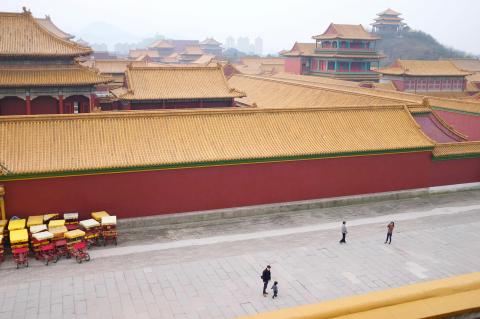Chinese film and television are reeling from what industry insiders call a “bitterly cold winter” of sharper government scrutiny that is expected to lead to more Communist Party-friendly content.
The entertainment sector had blossomed in recent years, with official encouragement by a government keen to replace foreign content with homegrown fare and develop the industry as a global “soft power” asset.
But a nationwide push for more party-approved material across media, music and entertainment has combined with a clampdown on spiraling screen-star salaries to cloud the outlook.

Photo: AFP
“(It’s been a) cold winter, a bitterly cold winter,” said Yu Zheng (于正), screenwriter and producer of the hugely popular series Story of Yanxi Palace (延禧攻略).
The period drama set amid Qing dynasty court intrigue drew 18 billion views on Chinese platform iQIYI and was the most Googled TV show in the world last year, due in part to popularity among the Chinese diaspora.
CLOUDY FUTURE

Photo: AFP
The program, since concluded, was filmed at Hengdian World Studios in the eastern province of Zhejiang.
Widely considered “China’s Hollywood,” the sprawling studio complex has around a dozen film sets including faux versions of Beijing’s Forbidden City and, soon, Shanghai’s Bund riverfront.
Around 70 percent of China’s film and television shows are shot there, Chinese newspaper Economic Observer reported in 2017.
But studio chairman Sang Xiaoqing (桑小慶) said that Hengdian is bracing for a slowdown, particularly after tax authorities late last year targeted A-list actress Fan Bingbing (范冰冰) in a crackdown on alleged widespread tax dodging and exorbitant pay for big-name stars.
“Judging from the current situation, (the entertainment industry) will be in the process of slow recovery in 2019,” Sang said.
“Some crew have postponed their shooting plans and some have even canceled. The business operations of film and television companies were also impacted by the strengthened tax reform.”
Sang said he expects to see a shift to more films or TV programs focused on the revolution that brought the Communists to power in 1949, particularly as this October will mark the event’s 70th anniversary.
Krypt Chen, a Shanghai-based media analyst, said: “[Government] scrutiny has been stricter year after year since 2016. It was already quite harsh last year and may be even stricter this year.”
China’s film industry earned a record of nearly 61 billion yuan (US$9.1 billion) in box-office revenue last year, up nine percent from 2017, state-run Xinhua news agency reported, though growth slowed from the previous year.
Radio and TV revenue, meanwhile, rose 20 percent in 2017.
But the tightened scrutiny has Chinese studios feeling the heat.
Entertainment giant Huayi Brothers Media Corporation’s share price was almost halved last year, and Hengdian stock shed more than 20 percent.
President Xi Jinping (習近平) is waging a campaign to sanitize media content, which has resulted in a crackdown on art forms like rap, while even tattoos are believed to have been banned from television.
INVESTMENT BUBBLE?
Historical shows like Yanxi Palace had seemed safe as they don’t deal with contentious contemporary issues.
But a commentary by Beijing Daily, an official Communist Party newspaper, last month touched off a debate by criticizing period dramas for glamorizing lavish imperial lifestyles and palace intrigue instead of promoting “the core values of socialism.”
Since then, similar shows appear to have gone into hiatus.
Yanxi producer Yu said he felt his show was in line with Xi’s goals of promoting and exporting Chinese culture.
“I think criticism is okay. But please don’t cut (all period dramas) across the board,” he said in a phone interview.
“China finally has a TV show that has been recognized by the world... Why can’t we bring out China’s good, luxurious things and let foreigners pay their respects?”
Hengdian chairman Sang said optimistically the newspaper commentary could result in content with more “positive energy,” while Chen, the analyst, said this will mean more traditional values.
Sang said demand remains high and he expects to see a shift toward better-developed plots, finely tuned production quality, and less reliance on big-name stars.
“There was excessive, bubble-like, investment,” Sang said. “Now, as people become rational and have calmed down, many good companies will have the opportunity to distance themselves from competitors.”

June 2 to June 8 Taiwan’s woodcutters believe that if they see even one speck of red in their cooked rice, no matter how small, an accident is going to happen. Peng Chin-tian (彭錦田) swears that this has proven to be true at every stop during his decades-long career in the logging industry. Along with mining, timber harvesting was once considered the most dangerous profession in Taiwan. Not only were mishaps common during all stages of processing, it was difficult to transport the injured to get medical treatment. Many died during the arduous journey. Peng recounts some of his accidents in

“Why does Taiwan identity decline?”a group of researchers lead by University of Nevada political scientist Austin Wang (王宏恩) asked in a recent paper. After all, it is not difficult to explain the rise in Taiwanese identity after the early 1990s. But no model predicted its decline during the 2016-2018 period, they say. After testing various alternative explanations, Wang et al argue that the fall-off in Taiwanese identity during that period is related to voter hedging based on the performance of the Democratic Progressive Party (DPP). Since the DPP is perceived as the guardian of Taiwan identity, when it performs well,

A short walk beneath the dense Amazon canopy, the forest abruptly opens up. Fallen logs are rotting, the trees grow sparser and the temperature rises in places sunlight hits the ground. This is what 24 years of severe drought looks like in the world’s largest rainforest. But this patch of degraded forest, about the size of a soccer field, is a scientific experiment. Launched in 2000 by Brazilian and British scientists, Esecaflor — short for “Forest Drought Study Project” in Portuguese — set out to simulate a future in which the changing climate could deplete the Amazon of rainfall. It is

Artifacts found at archeological sites in France and Spain along the Bay of Biscay shoreline show that humans have been crafting tools from whale bones since more than 20,000 years ago, illustrating anew the resourcefulness of prehistoric people. The tools, primarily hunting implements such as projectile points, were fashioned from the bones of at least five species of large whales, the researchers said. Bones from sperm whales were the most abundant, followed by fin whales, gray whales, right or bowhead whales — two species indistinguishable with the analytical method used in the study — and blue whales. With seafaring capabilities by humans